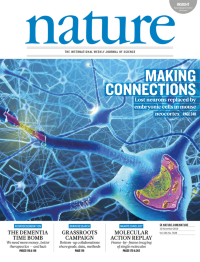Volume 539
-
No. 7630 24 November 2016
Scanning transmission electron microscopy (STEM) has advanced to the point that it could soon be used to create materials from scratch, atom by atom. In a Comment piece in this weeks Nature, Sergei Kalinin, Albina Borisevich and Stephen Jesse propose an approach to that challenge. The method involves passing an electron beam through a specimen to reveal its crystal structure. What is a downside in conventional structural determinations, that the beam can displace atoms, becomes an upside if you want to move atoms around though for the technique to succeed it will be necessary to obtain full control over the beam. Cover: XVIVO Scientific Animation.
-
No. 7629 17 November 2016
A Seattle cannabis worker cradles the resin-dusted bud of a strain called Blueberry Cheesecake. The legalization of marijuana has become a topic of debate in the United States and recent reports suggest that cannabis has now overtaken heroin as the most reported illicit drug in users seeking specialist addiction care in Europe. However, there are stark differences in the scientific literature as to how Δ9-tetrayhydrocannabinol (THC), the psychoactive compound in marijuana, affects neural networks, such as the dopamine-driven reward system. In this issue of Nature, Michael Bloomfield et al. review the conflicting evidence between clinical and animal research studies. They conclude that THC exposure produces complex and potentially long-term effects on the dopamine system including increased nerve firing and dopamine release in response to acute THC, and dopaminergic blunting associated with long-term use. Future research, they suggest, should focus on the relationships between cannabis-induced alterations in the dopamine system and behavioural effects in humans and animal models. Cover : Lynn Johnson/National Geographic Creative
-
No. 7628 10 November 2016
Artistic representation of interconnected neurons at cellular resolution. With neuronal regeneration being extremely limited in the adult mammalian neocortex, one possible strategy to drive repair in the brain following injury is to utilize transplanted embryonic neurons. However, it is not known how well these neurons develop and integrate into established circuits in the adult. A study published in this issue of Nature uses two-photon microscopy and monosynaptic tracing to show that embryonic neurons transplanted into the visual cortex of adult mice can mature and achieve adult-like properties within four to eight weeks, receiving appropriate inputs and establishing sensory stimulus selective responses. Cover art by Ara Hacobian.
-
No. 7627 3 November 2016
A stylized hand skeleton of the Rosa26Hoxa11/Hoxa11 ; prx1Cre mutant mouse. This mutation results in expression of the Hoxa11 gene in distal limb buds, reminiscent of the expression in fin buds, and triggers the formation of extra-digits. Mosty living tetrapods the four-legged land vertebrates have five digits per limb. If this number varies through mutation, its always a reduction from the canonical five. But this state, called pentadactyly, wasnt always so hardwired. The earliest tetrapods had six, seven or even eight digits per limb a polydactyly seen nowadays only in rare mutations. How did pentadactyly become established? Marie Kmita and colleagues show that mutually exclusive expression of Hoxa11 and Hoxa13 is required for five-digit limbs, that a transcriptional enhancer has evolved in the intron of the Hoxa11 gene, and that its function is required to maintain the pentadactyl state. The authors propose that the evolution of Hoxa11 regulation has contributed to the transition from polydactyly in stem- group (extinct) tetrapods to pentadactyly in extant tetrapods. Cover by Yacine Kherdjemil & Marie Kmita




